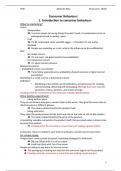TEW Alexis De Mey Final score: 16/20
Consumer Behaviour:
1. Introduction to consumer behaviour:
What is marketing?
Critics:
- Manipulative
It pushes people to buying things they don’t need, it overpromises (nice on
packaging but bad in reality), spam.
- Fluff
It’s BS, unfounded, lacks scientific rigger --> therefore it’s not useful.
- Wasteful
People see marketing as a cost, what is the influence on the profitability?
Bart:
- No rocket science
It’s not exact, not deterministic but probabilistic.
- It is behavioral science.
It’s about human behavior.
Behavioral science:
= probabilistic (more uncertainty)
If you follow a good process, probability of good outcome is higher but not
guaranteed.
Marketing is a social science, a behavioral science.
Definition:
• Marketing is the activity, set of institutions, and processes for creating,
communicating, delivering and exchanging offerings that have value for
customers, clients, partners, and society at large.
Creating value for consumers is more than just making a good product.
Wine tasting experiment:
- Liking without price:
They are not fooled; they give a correct value to the wines. They give the same value to
identical wines in different glasses.
The value is determined by the product itself.
- Liking with price:
They value the product based on the price and not on the taste so not on the product,
The value is determined by the price of the product.
A marketing valuable overwhelms the product itself; the perceived value is driven more
by price than product.
Creating value for consumers is more than just making a good product.
Conclusion: Value is created in your brain (it activates a certain part in your brain)
Ice cream study:
Haegen Dazs: name sounds European, marketing strategy (it’s American)
Big cup (10oz) with 8 oz of ice cream
Small cup (5oz) with 7oz of ice cream
People are willing to pay more for less ice cream.
The packaging is creating the value for the consumer (again not the product)
Creating value for consumers is more than just making a good product.
1
,Experiment with 50 new songs:
Market A: these consumers cannot interact with each other; nobody will know how
often you listen to a song.
Market B: the same
Social market A: they can observe what other consumers listen to.
Social Market B: same
The correlation will be higher in the independent market.
They value the song on just the song, the popularity of the song is influenced by
the likeability of the song and nothing else.
Social market: people’s liking of the song will be influenced by other people’s
viewing and the song --> Where people interact there is a lot of
unpredictability.
There will be more blockbuster hits in the social market:
You see that other people listen that song, so you think that one must be good …
Value = f (marketing mix):
Product, Price, Place and Promotion
Value is a function of the marketing mix.
2 sides of customer value:
1) Value TO customers (for customers)
2) Value OF customers (value that you extract from these customers)
Low 1 and High 2: You offer low value to customers, but they provide a lot of value to
you --> Ticket master (people are not satisfied but use it nevertheless due to few
alternatives)
Satisfaction experiment:
Which result do you prefer?
How valuable are these customers and the
profitability is important, not really how
satisfied they are. It is important but if you
need to choose out of the 3 graphs (result
C) is what you want, the very satisfied are
very valuable and so profitable.
(It’s possible that people who give 1,2,3 or a 4 don’t spend a lot but only those that
give a 5 are very profitable for you)
Convex: companies that really want to delight their
customers (competitive market)
Concave: companies that don’t want to piss off their
customers, they only leave the company if they’re
really really pissed (high switching costs) (less
competitive)
Result B is better for them.
2
, TEW Alexis De Mey Final score: 16/20
How do you measure value of customers?
- Customer Acquisition Cost (CAC) = The total cost to acquire customers divided by
the number of new customers acquired.
- Customer margin = Revenue generated by customers minus the cost to serve.
- Retention rate = The percent of customers from the previous period that are still
active in the current period.
Integration of the 3 above:
- Customer Lifetime Value (CLV) = The aggregate profit a customer brings to a firm
over the entire duration of the relationship between the customer and the firm.
Marketing is about creating value to consumers by
managing the marketing mix. But not just to any
consumer, to consumers that provide value to you (CLV).
What is the secret to success in marketing?
Confidence percentage > accuracy percentage
Horizontal axis: confidence
Vertical axis: accuracy
People are overconfident in an asymmetric way, if you say
50% (I don’t know, you don’t know --> if you think you’re
sure, there is a good chance that you’re wrong)
50%, you’re above/on the perfect line.
100% sure, you’re under the perfect line.
You need to be curious, ask a lot of questions. If you’re overconfident, you don’t ask
questions --> Overconfidence is an important hurdle to success.
Second quiz:
GREEN: Familiar topics, they seem easy and so you think you’re pretty good in
them
RED: niche topics so you don’t know much
SUM GREEN will be higher than SUM RED
But the question is: if you would win from your opponent. The other person doesn’t
know much either about 1,2,4,7,8 and also much about 2,3,5,6.
There shouldn’t be a systematic difference. The reason is:
Ego centric bias, you watch through your lens, and you overweigh yourself, how
much do I know? (Not how much does the other person know?)
Solution: Step into consumer shoes and look into the world from their shoes
Problems of couples/advertising/… --> Often a consequence of inability to take
perspective.
3




